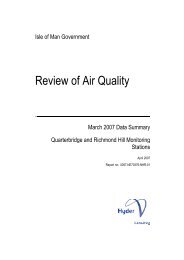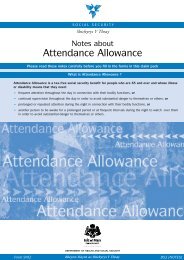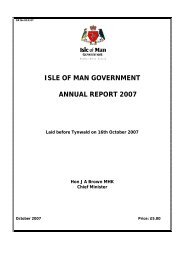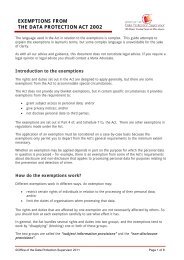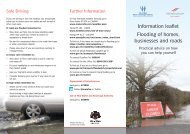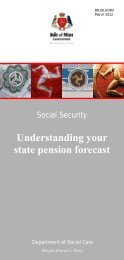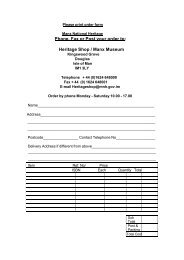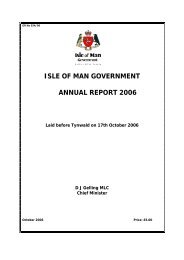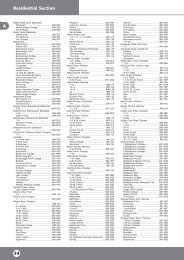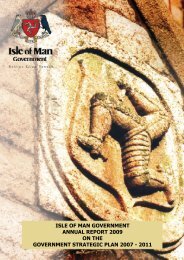Commercial Yacht Master's Handbook - Isle of Man Government
Commercial Yacht Master's Handbook - Isle of Man Government
Commercial Yacht Master's Handbook - Isle of Man Government
You also want an ePaper? Increase the reach of your titles
YUMPU automatically turns print PDFs into web optimized ePapers that Google loves.
<strong>Commercial</strong> <strong>Yacht</strong><br />
Master’s <strong>Handbook</strong><br />
www.iomshipregistry.com<br />
June 2010
Introduction<br />
This handbook is designed for all Masters and senior <strong>of</strong>ficers <strong>of</strong> <strong>Isle</strong> <strong>of</strong> <strong>Man</strong> registered <strong>Commercial</strong><br />
<strong>Yacht</strong>s i.e. Large <strong>Yacht</strong> Code Compliant <strong>Yacht</strong>s.<br />
Please read it as it should answer most <strong>of</strong> your questions regarding <strong>Isle</strong> <strong>of</strong> <strong>Man</strong> Merchant Shipping<br />
Regulations and the administrative processes required in running an <strong>Isle</strong> <strong>of</strong> <strong>Man</strong> <strong>Commercial</strong> <strong>Yacht</strong><br />
Masters, and other seafarers, serving in <strong>Isle</strong> <strong>of</strong> <strong>Man</strong> yachts are always welcome to contact the <strong>Isle</strong><br />
<strong>of</strong> <strong>Man</strong> Ship Registry by phone, fax or email. If there is any way in which the Ship Registry can<br />
assist by providing advice or support the staff will always attempt to provide the maximum<br />
assistance possible.<br />
Further information, including current legislation and advice, can be obtained by accessing the<br />
Ship Registry’s web site at:<br />
http://www.iomshipregistry.com<br />
Tel: +44-1624-688500<br />
Fax: +44-1624-688501<br />
Emergency after hours contact number: +44-7624-493467<br />
E-Mail address marine.survey@gov.im<br />
Certified to the ISO9001:2008 Quality Standard and the Investor in People Standard
1. <strong>Commercial</strong> Certification<br />
2. Crew agreement and articles<br />
3. Official log book<br />
4. Publications to be carried<br />
5. LRIT<br />
6. Safety <strong>of</strong>ficials and committees<br />
7. Accident reporting<br />
8. Hours <strong>of</strong> rest<br />
TABLE OF CONTENTS<br />
9. <strong>Isle</strong> <strong>of</strong> man surveyors and classification societies<br />
10. <strong>Man</strong>ning requirements<br />
11. Mini ISM<br />
12. Continuous synopsis record (CSR)<br />
13. Complaints procedure<br />
14. Frequently asked questions
Amendments<br />
VERSION DATE Revision History<br />
1.00 08/05/2005 Initial Version<br />
2.00 14/06/2006 Version 02<br />
3.00 12/04/2007 Version 03<br />
4.00 14/06/2010 Version 04<br />
4.10 03/05/2011 Correction to page 20<br />
Note: New additions are marked by a vertical black line in the left margin.
1 <strong>Commercial</strong> Certification<br />
<strong>Commercial</strong> or Pleasure mode, it does not matter!<br />
All <strong>Commercial</strong> yachts are issued with a Certificate <strong>of</strong> Compliance with the large commercial yacht<br />
code, be this LY1 or LY2. In order for this status to be maintained an annual survey must take<br />
place as described in section 9 <strong>of</strong> this publication.<br />
Even if the yacht switches to Pleasure Mode operation then these annual surveys must continue in<br />
order to maintain the large commercial yacht code certification. If the annual survey is not<br />
completed within the window the large yacht code certificate becomes invalid which may have<br />
repercussions on the yacht’s insurance.<br />
For example:<br />
A yacht gains it Large <strong>Yacht</strong> Code Compliance certificate 14th June 2003 but then it is decided to<br />
operate the yacht in Pleasure Mode commencing 8 th September 2003. In 2004 no annual yacht<br />
code survey takes place so that on 14 th September 2004 (the end <strong>of</strong> the window for survey) that<br />
yacht loses its large commercial yacht compliance. Should the yacht want to regain the certificate<br />
we would have to revisit that yacht in order to carry out another survey to confirm compliance<br />
with the large yacht code. Who carried out the annual survey is described in Section 9.<br />
A <strong>Commercial</strong> yacht may only hold either a <strong>Commercial</strong> certificate <strong>of</strong> Registry (The blue book) or a<br />
Pleasure certificate <strong>of</strong> Registry. If the yacht wants to change between <strong>Commercial</strong> and Pleasure<br />
registry the Registry must be contacted in the first instance on registry.marine@gov.im<br />
NOTE – The certificate <strong>of</strong> registry is a totally separate document from the certificate <strong>of</strong> compliance<br />
with the large yacht code.<br />
<strong>Yacht</strong> Masters <strong>Handbook</strong> Page 1 <strong>of</strong> 33<br />
June 2010
2 Crew agreement and articles<br />
You must have a crew agreement and articles on<br />
board. This is how to complete them.<br />
Introduction<br />
<strong>Isle</strong> <strong>of</strong> <strong>Man</strong> registered commercial yachts are required to carry and<br />
maintain the following Crew Agreements and articles -<br />
Crew Agreement<br />
Every <strong>Isle</strong> <strong>of</strong> <strong>Man</strong> yacht shall have an agreement in writing, in a form approved by the <strong>Isle</strong> <strong>of</strong> <strong>Man</strong><br />
Ship Registry, between each person employed and the person employing him. These <strong>of</strong>ficial crew<br />
agreements are additional to and separate from any company contract or similar document.<br />
There is a standard form <strong>of</strong> approved crew agreement supplied by the Ship Registry for each<br />
yacht.<br />
The crew agreement and the <strong>of</strong>ficial log book are closely related documents. These are obtained<br />
directly from the <strong>Isle</strong> <strong>of</strong> <strong>Man</strong> Ship Registry.<br />
Because the crew agreement is a requirement <strong>of</strong> both an Act <strong>of</strong> the <strong>Man</strong>x Parliament and an ILO<br />
Convention, it must be used and its correct use is <strong>of</strong> importance. Failure to keep an approved<br />
crew agreement constitutes an <strong>of</strong>fence.<br />
This section sets out the main requirements for opening, maintaining, and subsequently closing a<br />
crew agreement.<br />
The master, on opening a crew agreement for the first time should insert at the top <strong>of</strong> the first<br />
section, the name <strong>of</strong> the employer and his address. This defines the parties to the agreement and<br />
will normally be either the name <strong>of</strong> the owner or <strong>of</strong> the manager who is employing the crew <strong>of</strong> the<br />
ship. Each seaman who then signs on the list <strong>of</strong> crew becomes a party to this agreement between<br />
himself and the employer.<br />
The crew agreement during the voyage<br />
Once the crew agreement is opened this is to be posted up in a conspicuous place next to the<br />
contractual clauses approved by the <strong>Isle</strong> <strong>of</strong> <strong>Man</strong> Ship Registry. If there is insufficient room for this<br />
to be displayed, it may be located somewhere on board to which all staff has access, for example<br />
a folder on the Bridge or in the Mess Room.<br />
Terminating a crew agreement<br />
At the end <strong>of</strong> the crew agreement it must be closed and all persons on it who have not already<br />
done so must sign <strong>of</strong>f in section (b) <strong>of</strong> the final column <strong>of</strong> the crew articles while the master<br />
should ensure that all the other shaded boxes are completed. The entry for “Date and Place <strong>of</strong><br />
leaving the ship” should be left blank if the crew member is to sign on another crew agreement<br />
immediately and is not therefore leaving the yacht, and as noted above the reason for discharge in<br />
this case will be “agreement terminated”.<br />
<strong>Yacht</strong> Masters <strong>Handbook</strong> Page 2 <strong>of</strong> 33<br />
June 2010
As soon as a crew agreement is closed and another one opened, the old one complete with all its<br />
parts which includes:<br />
• Cover Page.<br />
• Contractual Clauses.<br />
• Forms ALC 1 (a),(b),(c).<br />
• Completed Official Log Book.<br />
• Radio logs covering the period <strong>of</strong> the agreement.(If yacht ≥ 300 GT)<br />
Should be delivered to the <strong>Isle</strong> <strong>of</strong> <strong>Man</strong> Ship Registry via whichever method the yacht’s operators<br />
have set up for this purpose.<br />
Length <strong>of</strong> crew agreement:<br />
If the yacht is employed:<br />
On frequent short voyages around the UK or <strong>Isle</strong> <strong>of</strong> <strong>Man</strong> – maximum 6 months.<br />
On voyages which terminate regularly in the UK or <strong>Isle</strong> <strong>of</strong> <strong>Man</strong> – maximum 12 months.<br />
On any other type <strong>of</strong> voyage – Maximum 24 months.<br />
Crew Articles (List <strong>of</strong> crew)<br />
Lists <strong>of</strong> crew, Forms ALC 1(a), (b) & (c)<br />
These are supplied with the crew agreement as follows:<br />
ALC1(a) – Used to record details <strong>of</strong> every member <strong>of</strong> the crew when they join the yacht.<br />
ALC1(b) – Used to record details <strong>of</strong> Masters and any other persons on board other than members<br />
<strong>of</strong> the crew, but not guests. I.e., Superintendents, riding squads, contract staff etc.<br />
ALC1(c) – Used to record details <strong>of</strong> anybody under the age <strong>of</strong> 18 employed on the yacht. This is<br />
in addition to those entries for the same person on the form ALC1 (a).<br />
Annual Leave<br />
Staff who go on annual leave from the yacht during their contract must ensure that they sign <strong>of</strong>f<br />
the articles when they leave and sign back on again when they return. This also includes periods<br />
<strong>of</strong> a few days when the crew member may be away from the vessel and not on yacht business. In<br />
this case the crew member should sign <strong>of</strong>f the articles and sign back on once he or she has<br />
rejoined the vessel. By signing on the articles the crew member is agreeing with the contract on<br />
board and as such the Master has responsibility.<br />
<strong>Yacht</strong> Masters <strong>Handbook</strong> Page 3 <strong>of</strong> 33<br />
June 2010
3 Official log book<br />
Maintaining this is a legal requirement!<br />
The Official Log Books Regulations require <strong>Isle</strong> <strong>of</strong> <strong>Man</strong> ships to carry and maintain an <strong>of</strong>ficial log<br />
book. This log book is a legal document and is an <strong>of</strong>ficial channel <strong>of</strong> communication between the<br />
master and the <strong>Isle</strong> <strong>of</strong> <strong>Man</strong> Ship Registry. It is also a document that is acceptable as evidence in<br />
court proceedings, therefore it is essential that it is regularly, correctly and accurately filled in.<br />
As the <strong>of</strong>ficial log book was originally designed for merchant vessels we have adapted it to be<br />
more yacht friendly and in a loose leaf format. Blank pages and PDF files are supplied when the<br />
<strong>Yacht</strong> comes on the register. They are also available by request via e-mail or can be downloaded<br />
from the <strong>Isle</strong> <strong>of</strong> <strong>Man</strong> Ship Registry web site as a PDF. All pages should be filled in by hand. (Should<br />
the yacht want to use the “old” paper book then we have objection to this although the Master<br />
may find it harder to complete)<br />
The entries in the log book cover such matters as records <strong>of</strong> seaman employed, musters and drills,<br />
inspections <strong>of</strong> accommodation and provisions, departure and arrival checks. The log book also has<br />
a narrative section for the recording <strong>of</strong> changes <strong>of</strong> masters, accidents and casualties, disciplinary<br />
matters, appointments <strong>of</strong> safety <strong>of</strong>ficers and committee meetings etc...<br />
The various sections should be filled in as follows:-<br />
Reference number in list <strong>of</strong> crew refers to Official List <strong>of</strong> Crew (ALC 1(a)).<br />
Section 2 Records <strong>of</strong> Drills, Safety Training and Safety Inspections<br />
Entries are required for the following:-<br />
1. Fire & Boat Drills (to be held monthly or within 24 Hrs <strong>of</strong> any new crew member with a role<br />
on the Muster List joining).<br />
2. Inflatable/Rescue Boat Drills (to be lowered to the water monthly).<br />
3. Life Saving Appliances and Fire Fighting Appliances Inspections (weekly and tested as<br />
appropriate on the 4 th week).<br />
4. Passenger’s safety induction (shortly after boarding).<br />
5. Any additional safety training conducted.<br />
An example <strong>of</strong> an entry would be:-<br />
Date Nature <strong>of</strong> Drill, Training or Inspection Signatures <strong>of</strong><br />
Master and<br />
Member <strong>of</strong><br />
crew<br />
25/12/05 General alarm sounded, crew mustered at emergency<br />
stations for a simulated galley fire, fire pumps and fire<br />
fighting equipment tested, crew mustered to abandon<br />
ship stations. Rescue Boat crews instructed in<br />
launching procedures.<br />
No deficiencies found.<br />
<strong>Yacht</strong> Masters <strong>Handbook</strong> Page 4 <strong>of</strong> 33<br />
R. Mellie<br />
Master<br />
B. Bacon<br />
Mate<br />
June 2010
If for any reason a muster or drill is not held then a statement as to the reason why should be<br />
entered in Column 2. Valid reasons might be ‘<strong>Yacht</strong> navigating in dense fog deemed unsafe to<br />
conduct drills’.<br />
Section 3 Record <strong>of</strong> Weekly Inspections <strong>of</strong> Crew Accommodation and provisions<br />
provided for the crew.<br />
These are mandatory inspections which must be carried out by the Master accompanied by a<br />
member <strong>of</strong> the crew, for compliance with the ILO conventions. Both must sign the entry for it to<br />
be valid.<br />
Section 4 Voyage details and pre-departure checks.<br />
A suitable entry is to be made every time the yacht leaves a port or an anchorage. This is to<br />
confirm that the freeboard has been verified and so the yacht has been deemed not to be<br />
overloaded. An entry is not required if the vessel ‘lunch stops’ at a minor anchorage. Steering<br />
gear is also included in this section; however there is no requirement to retest this if it has already<br />
been done so within the previous 12 hours. When the yacht arrives at the next port date and hour<br />
<strong>of</strong> arrival and location is to be recorded.<br />
Section 5 Narrative Section<br />
This section should contain entries relating to:-<br />
Changes in Master<br />
Change in <strong>Yacht</strong> Mode <strong>Commercial</strong>/Private<br />
Deviations to hours <strong>of</strong> rest<br />
Accidents<br />
Casualties<br />
Disciplinary Matters<br />
Crew members discharged or left behind<br />
Desertions<br />
Complaints<br />
Promotions and demotions<br />
Criminal convictions during a voyage<br />
Illness<br />
Deaths<br />
Appointments <strong>of</strong> Safety Officers, representatives and committees<br />
Meetings <strong>of</strong> Safety Committees<br />
Wage disputes<br />
Closing <strong>of</strong> the Official Log Book<br />
<strong>Yacht</strong> Masters <strong>Handbook</strong> Page 5 <strong>of</strong> 33<br />
June 2010
Examples <strong>of</strong> entries would be:-<br />
Section 1 Record <strong>of</strong> Seamen Employed<br />
Date and<br />
hour <strong>of</strong> the<br />
occurrence<br />
1000Hrs<br />
4/6/05<br />
1215Hrs<br />
5/7/05<br />
O900Hrs<br />
6/7/05<br />
1330Hrs<br />
12/7/05<br />
1700Hrs<br />
13/7/05<br />
2300Hrs<br />
24/7/05<br />
1100Hrs<br />
27/7/05<br />
1700Hrs<br />
27/7/05<br />
2030Hrs<br />
15/8/05<br />
Place <strong>of</strong> the<br />
occurrence<br />
or situation by<br />
latitude and<br />
longitude at sea<br />
Date<br />
<strong>of</strong><br />
entry<br />
<strong>Yacht</strong> Masters <strong>Handbook</strong> Page 6 <strong>of</strong> 33<br />
Narrative Entry<br />
Nice 4/6/06 This is to certify that I have this day opened crew articles and<br />
the crew members in the list <strong>of</strong> crew have signed on the articles<br />
before me, and I have opened this Official Log Book..<br />
R. Mellie, master B. Bacon Ch Officer<br />
San Remo 5/7/06 This is to certify that ref. No. 1 Capt. B. Bacon has been<br />
superseded as master <strong>of</strong> this yacht by ref. No. 35, Capt. F.<br />
Palmer. All documents relevant to the safe navigation <strong>of</strong> the<br />
vessel and to her crew have been handed over on good order.<br />
R. Mellie, outgoing master F. Palmer, master<br />
Antibes 6/7/06 This day the yacht changed mode to operate as a <strong>Commercial</strong><br />
<strong>Yacht</strong> boarding a party <strong>of</strong> 12 guests at Antibes.<br />
F. Palmer master B. Bacon Ch Officer.<br />
at sea<br />
15 deg. N<br />
59 deg W<br />
12/7/06 This day Mr M. Baker, AB. No. 14 in the list <strong>of</strong> crew fell while<br />
working on deck. First aid treatment given and contact made<br />
with medical authorities ashore. Further treatment given in<br />
accordance with instructions. Mr Baker confined to bed and<br />
under observation.<br />
Completed form ARF 1 for transmission to the <strong>Isle</strong> <strong>of</strong> <strong>Man</strong> Ship<br />
Registry<br />
F. Palmer master B. Bacon Ch Officer<br />
St Kitts 13/7/06 This day Mr Baker signed <strong>of</strong>f the crew articles and landed<br />
ashore for medical treatment.<br />
F. Palmer master B. Bacon Ch Officer<br />
at sea<br />
45 deg W<br />
30 deg S<br />
24/7/06 This day it was reported to me that Mr E Ace, deckhand No. 42<br />
in the list <strong>of</strong> crew reported for lookout duty while apparently<br />
intoxicated. Interviewed Mr. Ace and established that the<br />
allegation was correct. Mr Ace admits to the <strong>of</strong>fence and<br />
declined to make further comment. Mr Ace was accompanied<br />
by his friend Mr Whicker No 28 in the list <strong>of</strong> crew.<br />
Reprimanded Mr Ace and informed him that his conduct was in<br />
breach <strong>of</strong> Master’s orders and Company rules. Advised him that<br />
any repetition would lead to instant dismissal. Gave Mr Ace a<br />
copy <strong>of</strong> this entry.<br />
F. Palmer master B. Bacon Ch Officer.<br />
Buenos Aries 27/7/06 This day appointed J. Navigat Second Officer as safety <strong>of</strong>ficer<br />
and Nos., 6, 8, and 10 in the list <strong>of</strong> crew as safety<br />
representatives to form the yacht’s safety committee.<br />
F. Palmer B. Bacon, Ch Officer<br />
Buenos Aries 27/7/06 This day signed <strong>of</strong>f Nos. 5, 12, and 14 in the list <strong>of</strong> crew to<br />
proceed on leave.<br />
F. Palmer master B. Bacon, Ch. Officer<br />
Cape Town 15/8/06 All crew members discharged from the crew agreement and<br />
<strong>of</strong>ficial log book closed this day.<br />
F. Palmer master B. Bacon, Ch Officer<br />
June 2010
Section 6 Births & Deaths<br />
Instructions for completing this section are contained in the section. It should be noted that in the<br />
section for births, the signature <strong>of</strong> the mother is required while in the section for deaths, the<br />
signature <strong>of</strong> the master AND the signature <strong>of</strong> a member <strong>of</strong> the crew are both required. The crew<br />
member may be any crew member.<br />
Official log books are normally closed after 12 months at the same time as the ship’s articles <strong>of</strong><br />
agreement, and returned to the <strong>Isle</strong> <strong>of</strong> <strong>Man</strong> Ship Registry for checking. A new <strong>of</strong>ficial log book is<br />
then opened, the log books being available from the <strong>Isle</strong> <strong>of</strong> <strong>Man</strong> Ship Registry.<br />
Multiple log books are not permitted.<br />
<strong>Yacht</strong> Masters <strong>Handbook</strong> Page 7 <strong>of</strong> 33<br />
June 2010
4 Publications to be carried<br />
The minimum publications that you are required<br />
to carry on board<br />
The following list is provided for guidance to masters and crew on the necessary manuals and<br />
main publications required to be carried on board yachts registered in the <strong>Isle</strong> <strong>of</strong> <strong>Man</strong>.<br />
Publication<br />
1. <strong>Man</strong>x Shipping Notices<br />
2. Stability Information (Static – all yachts. Damage – all yachts except short range)<br />
3. Garbage <strong>Man</strong>agement Plan and Records<br />
5. SOPEP (if ≥ 400GT)<br />
6. Oil Record Book Part 1<br />
7. Nautical Publications applicable to the area <strong>of</strong> operation:<br />
• International Code <strong>of</strong> Signals (a statutory requirement)<br />
• Navigation Charts<br />
• Mariners’ <strong>Handbook</strong><br />
• Sailing Directions<br />
• Operational and Maintenance Instructions for<br />
Navigational Aids carried by the ship<br />
• List <strong>of</strong> Lights and Radio Signals<br />
• IAMSAR Volume III <strong>Man</strong>ual (a statutory requirement)<br />
• Notice to mariners<br />
• Nautical Almanac<br />
• Tide Tables<br />
• Tidal Steam Atlas<br />
• Navigational Tables<br />
Note – all charts and publications to be updated as far as reasonably practical as<br />
necessary for the forthcoming voyage<br />
8. Official Log Book<br />
9. Articles <strong>of</strong> Agreement<br />
10. Fire Training <strong>Man</strong>uals<br />
11. Fire Safety Operational Booklets<br />
12. LSA Training <strong>Man</strong>ual<br />
13. LSA Maintenance Instructions<br />
14. Information for Radio Installation (GMDSS)<br />
15. Code <strong>of</strong> Safe Working Practice for<br />
Merchant Seamen<br />
16. Compass Error Book<br />
17. Record <strong>of</strong> last overhaul <strong>of</strong> LSA launching appliances<br />
Mariners <strong>Handbook</strong>: A compendium <strong>of</strong> essential maritime information on charts; operations and regulations; tides,<br />
currents and characteristics <strong>of</strong> the sea; basic meteorology; navigation in ice, hazards and restrictions to navigation;<br />
and the IALA Buoyage system<br />
Sailing Directions: Often referred to as Pilots, Sailing Directions are designed for use by the mariner on all classes <strong>of</strong><br />
vessels with essential information on all aspects <strong>of</strong> navigation<br />
List <strong>of</strong> Radio Signals : Comprehensive information on all aspects <strong>of</strong> Maritime Radio Communications<br />
List <strong>of</strong> Light Signals: This series <strong>of</strong> books provides extensive information on all lighthouses, lightships, lit floating<br />
marks (over 8m in height), fog signals and other lights <strong>of</strong> navigational significance.<br />
IAMSAR Volume III manual: Guidelines on search and rescue.<br />
Notice to Mariners: Contains all the corrections, alterations and amendments for the UKHO's worldwide series <strong>of</strong><br />
Admiralty Charts and Publications<br />
Navigational Tables: e.g. Nories nautical almanac<br />
<strong>Yacht</strong> Masters <strong>Handbook</strong> Page 8 <strong>of</strong> 33<br />
June 2010
Note that there is no requirement to carry <strong>Isle</strong> <strong>of</strong> <strong>Man</strong> Acts and Regulations on board the yacht.<br />
However these do contain useful information, and where relevant in this handbook they have been<br />
referred to. They are all available for download.<br />
GMDSS Radio Log Book<br />
All <strong>Isle</strong> <strong>of</strong> <strong>Man</strong> yachts are required by law to keep records <strong>of</strong> communications relating to distress,<br />
urgency and safety traffic, records <strong>of</strong> important incidents connected with the radio service, regular<br />
positions <strong>of</strong> the ship, and results <strong>of</strong> tests carried out on the radio equipment.<br />
Instructions for the maintenance <strong>of</strong> this log are contained in the log book and log books are<br />
available from the <strong>Isle</strong> <strong>of</strong> <strong>Man</strong> Ship Registry.<br />
The log books should be returned to the <strong>Isle</strong> <strong>of</strong> <strong>Man</strong> Ship Registry when the last entry is made.<br />
Oil Record Book (part 1)<br />
MARPOL Annex I applies to all ships, and therefore all yachts, and is enforced by the <strong>Isle</strong> <strong>of</strong> <strong>Man</strong><br />
Ship Registry.<br />
International legal requirements are that an oil record book part 1, covering machinery space<br />
operations, shall be maintained by all ships <strong>of</strong> 400gt and over.<br />
IOM legal requirements are that an oil record book part 1, covering machinery space operations,<br />
shall be maintained by all ships <strong>of</strong> 80gt and over.<br />
This oil record book shall contain entries relating to:-<br />
Ballasting or cleaning <strong>of</strong> oil fuel tanks, discharge <strong>of</strong> ballast or cleaning water from oil fuel tanks,<br />
disposal <strong>of</strong> oily residues (sludge) and discharge overboard <strong>of</strong> bilge water which has accumulated in<br />
machinery spaces, bunkering operations and accidental discharges <strong>of</strong> oil.<br />
Such operations requiring recording are listed in the front <strong>of</strong> the oil record book.<br />
It is most important that oil record books are regularly, correctly and accurately maintained as<br />
they are frequently scrutinised by port state authorities whilst checking for possible illegal<br />
discharges.<br />
There should be no blank lines in the book.<br />
All entries must be signed.<br />
Oil record books can be obtained from the <strong>Isle</strong> <strong>of</strong> <strong>Man</strong> Ship Registry and completed books shall be<br />
kept for a period <strong>of</strong> 3 years after the last entry, but are not required to be returned to the Ship<br />
Registry.<br />
<strong>Yacht</strong> Masters <strong>Handbook</strong> Page 9 <strong>of</strong> 33<br />
June 2010
5 Long Range Identification and Tracking (LRIT)<br />
300gt and over? Read this.<br />
All commercial yachts (Those with a Large <strong>Yacht</strong> Code Certificate) <strong>of</strong> 300gt and over are required<br />
to comply with LRIT requirements. This little box sits out <strong>of</strong> the way and it is monitored by your<br />
service provider.<br />
When this has been commissioned the yacht must request a Conformance Test Report Certificate<br />
and send a copy <strong>of</strong> this to our <strong>of</strong>fice so we can put your yacht on the system. More information on<br />
this can be found in MSN 028<br />
Instructions as to when it is permissible for a vessel to cease LRIT transmissions<br />
In general all vessels should continue to transmit information at a rate <strong>of</strong> once every 360 minutes<br />
and should not under any circumstances switch <strong>of</strong>f their LRIT units or reduce the frequency <strong>of</strong><br />
transmission.<br />
The only exceptions to this are as follows:<br />
a) Where the vessel is in dry-dock or undergoing modification in a shipyard or port for a period<br />
where continued interruption <strong>of</strong> the system would cause undue problems and an application<br />
has been made to the Ship Registry and agreement received;<br />
b) Where the vessel is to be placed in long term lay-up and an application is made to the Ship<br />
Registry by the Operator to reduce the transmission rate or to stop transmission for a set<br />
period and agreement received.<br />
The Ship Registry can be contacted at marine.survey@gov.im for any enquires regarding making<br />
an application to reduce or terminate transmissions under these circumstances.<br />
In addition to this an entry is to be made in the Official Log Book indicating the time and date the<br />
unit was switched <strong>of</strong>f and a corresponding entry made as to when the unit is re-started and<br />
transmissions recommenced.<br />
See MSN 032 for further guidance.<br />
<strong>Yacht</strong> Masters <strong>Handbook</strong> Page 10 <strong>of</strong> 33<br />
June 2010
6 Safety <strong>of</strong>ficials and safety committees<br />
5 or more persons employed on board? Read on.<br />
Role <strong>of</strong> Safety Officials & Safety Committees<br />
Every person on board a vessel has a responsibility for safety. Merchant Shipping legislation<br />
provides for specific responsibilities to those personnel with designate duties in ensuring the safety<br />
<strong>of</strong> those on the vessel. A vessel’s safety culture is dependent upon the high standards <strong>of</strong> safety<br />
which can only be achieved by strong support and encouragement from the vessel’s senior<br />
management.<br />
The Regulations dealing with Safety Officials lay requirements on the company/operator for the<br />
appointment <strong>of</strong> vessel’s Safety Officers, the appointment <strong>of</strong> a safety committee and the election <strong>of</strong><br />
safety representatives with specific powers.<br />
On every vessel in which five or more persons are employed the Company/operator is<br />
required to appoint a safety <strong>of</strong>ficer. The Master is required to record this appointment <strong>of</strong> a Safety<br />
Officer in the <strong>of</strong>ficial log book. The Safety Officer should have adequate training for the role, be<br />
familiar with the statutory responsibilities for health and safety and with the principles and practice<br />
<strong>of</strong> risk assessment. This training could be in the form <strong>of</strong> a computer or video/DVD course from a<br />
suitable training company. Where this training is not available on board or within the management<br />
company, then it is strongly advised that the designated Safety Officer attends a suitable training<br />
course. If possible the Company/operator should avoid appointing as Safety Officer anyone to<br />
whom the Master has delegated the task <strong>of</strong> giving medical treatment.<br />
• amongst the duties <strong>of</strong> the Safety Officer it is the responsibility to ensure that the provisions<br />
<strong>of</strong> the Code <strong>of</strong> Safe Working Practices and the Company’s/operator’s occupational health and<br />
safety policies are complied with.<br />
• investigate every accident or incident ocurring on board and any potential hazard to<br />
occupational health and safety.<br />
• carry out occupational health and safety inspections <strong>of</strong> each accessible part <strong>of</strong> the vessel in<br />
which the crew may be required to work at least once every three months or more<br />
frequently if there have been changes in the working conditions.<br />
• stop any work which he reasonably believes may cause an accident and inform the Master<br />
who shall be responsible for deciding when work can safely be resumed.<br />
• ensure the minutes <strong>of</strong> each safety committee meeting are accessible to all the crew.<br />
On every vessel in which five or more persons are employed the Company/operator is required to<br />
make rules and arrangements for the <strong>of</strong>ficers and ratings to elect safety representatives. The<br />
Regulations specify that no safety representative shall have less than two years consecutive sea<br />
service since attaining the age <strong>of</strong> 18 years. The Master must record the election or appointment <strong>of</strong><br />
safety representatives this should be in the <strong>of</strong>ficial log book. When there is a substantial change<br />
in the number <strong>of</strong> crew the Master should remind personnel <strong>of</strong> their right to elect new safety<br />
representatives. The number <strong>of</strong> safety representatives who should be elected will vary according<br />
to the size <strong>of</strong> the crew<br />
• in a vessel carrying fewer than 16 crew, one safety representative elected by the <strong>of</strong>ficers and<br />
ratings<br />
• in a vessel carrying 16 or more crew, one safety representative elected by the <strong>of</strong>ficers and<br />
one elected by the ratings.<br />
<strong>Yacht</strong> Masters <strong>Handbook</strong> Page 11 <strong>of</strong> 33<br />
June 2010
• in a vessel carrying more than 30 ratings one safety representative elected by the ratings<br />
from each <strong>of</strong> the deck engine and catering departments.<br />
The responsibilities and duties <strong>of</strong> a safety representative include amongst others:-<br />
• to participate in any investigations or inspections carried out by the Safety Officer subject to<br />
his agreement, or after notification to the Master, undertake similar investigations or<br />
inspections himself, whether or not they have been carried out by the Safety Officer.<br />
• on behalf <strong>of</strong> the crew on matters affecting occupational health and safety <strong>of</strong> crew members;<br />
consult with the Master and Safety Officer and make recommendations to them, request<br />
through the safety committee an investigation by the Safety Officer <strong>of</strong> any such safety<br />
matter.<br />
• inspect any <strong>of</strong> the records required to be kept by the Safety Officer.<br />
Once the safety <strong>of</strong>ficials have been appointed or elected as may be the case, the Master shall<br />
appoint a safety committee which shall include the Safety Officer and every safety representative.<br />
The Master shall be the chairman <strong>of</strong> the safety committee. The safety committee shall hold<br />
meetings at such intervals as it may decide but in any case at intervals <strong>of</strong> not more than 6 weeks.<br />
The appointment <strong>of</strong> every safety committee shall be recorded by the Master in the <strong>of</strong>ficial log<br />
book. The duties <strong>of</strong> the safety committee shall be amongst others:-<br />
• to ensure that the provisions <strong>of</strong> the Code <strong>of</strong> Safe Working Practices, relevant legislation and<br />
shipping notices are complied with to improve the standard <strong>of</strong> safety consciousness among<br />
the crew.<br />
• make representations and recommendations on behalf <strong>of</strong> the crew to the Company/operator<br />
on matters relating to occupational health and safety <strong>of</strong> the crew.<br />
• ensure the Company’s/operator’s occupational health and safety policies are observed and to<br />
make recommendations for their improvement.<br />
• inspect any <strong>of</strong> the records required to be kept by the Safety Officer and ensure that any<br />
conclusions reached on matters <strong>of</strong> safety are followed up.<br />
It shall be the duty <strong>of</strong> the Company/operator, and Master to facilitate the work <strong>of</strong> the Safety<br />
Officer, safety representatives and safety committee in carrying out their duties, amongst others<br />
to:-<br />
• provide access to any necessary safety information, documents, shipping notices and<br />
relevant regulations.<br />
• inform the Safety Officer, safety representatives and safety committee <strong>of</strong> any hazards on<br />
board the ship known to them which may endanger the ship or her crew.<br />
• permit occupational health and safety inspections <strong>of</strong> any accessible part <strong>of</strong> the vessel where<br />
crew members may be required to work.<br />
<strong>Yacht</strong> Masters <strong>Handbook</strong> Page 12 <strong>of</strong> 33<br />
June 2010
It is very important the Master takes a close interest in the work <strong>of</strong> the safety <strong>of</strong>ficials. He should<br />
check the Safety Officer is fulfilling his responsibilities effectively, but should give support and<br />
encouragement. The Master is the person best situated to ensure the safety committee works<br />
successfully by encouraging all crew members to participate in the ship’s safety culture.<br />
For further guidance refer to:-<br />
M/S (Safety Officials, General Duties and Protective Equipment) Regs 2001 (SD 816/01) Code <strong>of</strong><br />
Safe Working Practices.<br />
Code <strong>of</strong> Safe Working Practices for Merchant Seamen<br />
<strong>Yacht</strong> Masters <strong>Handbook</strong> Page 13 <strong>of</strong> 33<br />
June 2010
7 Accident reporting<br />
If you have a casualty or accident we need to<br />
know!<br />
Reporting and Submitting Reports.<br />
The Regulations place a duty on the Master or operator to report casualties and accidents by the<br />
quickest means possible and as soon as possible after the occurrence to the <strong>Isle</strong> <strong>of</strong> <strong>Man</strong> Ship<br />
Registry. Details concerning casualties should be reported either by e-mail or phone as soon as<br />
possible, with the paperwork to follow.<br />
The Regulations interpret accidents and casualties as follows: -<br />
Accidents: - as an occurrence which caused material damage to any ship or structure or damage<br />
to the health <strong>of</strong> any person or serious injury.<br />
Casualties: - cover occurrences such as, loss <strong>of</strong> life, loss <strong>of</strong> the ship, collision <strong>of</strong> the ship,<br />
pollution incidents etc...<br />
<strong>Man</strong>x Shipping Notice No 03 contains all the information required to assist in completing the<br />
ARF 1.<br />
It should be noted that the ARF 1 is used for both accident and casualty reporting and is the only<br />
correct means <strong>of</strong> reporting these occurrences to the <strong>Isle</strong> <strong>of</strong> <strong>Man</strong> Ship Registry. Copies <strong>of</strong> this<br />
form should be on board in printed form or available on the computer. If the yacht already uses its<br />
own accident reporting form that contains all the same information that can be found in Form ARF<br />
1, then the use <strong>of</strong> this is acceptable to the Ship Registry.<br />
If any <strong>of</strong> the above-mentioned documents are not on board then please contact the <strong>Isle</strong> <strong>of</strong> <strong>Man</strong><br />
Representative Person <strong>of</strong> the vessel or they may be obtained direct from the <strong>Isle</strong> <strong>of</strong> <strong>Man</strong> Ship<br />
Registry or from the website.<br />
For further guidance refer to:-<br />
Merchant Shipping (Accident Reporting and Investigation) Regulations 2001 (SD 815/01);<br />
<strong>Man</strong>x Shipping Notice 03;<br />
Form ARF 1 Version January 2006 (or later).<br />
<strong>Yacht</strong> Masters <strong>Handbook</strong> Page 14 <strong>of</strong> 33<br />
June 2010
8 Hours <strong>of</strong> rest<br />
Fatigue is important for the safety <strong>of</strong> all on board<br />
and so rest hours must be recorded.<br />
This applies to all <strong>Isle</strong> <strong>of</strong> <strong>Man</strong> <strong>Commercial</strong> <strong>Yacht</strong>s.<br />
Every seafarer shall be provided with “rest” in accordance with Section A-VIII/1 <strong>of</strong> the STCW<br />
Code.<br />
“Seafarer” means any person who is employed or engaged in any capacity on board a <strong>Commercial</strong><br />
<strong>Yacht</strong> on the business <strong>of</strong> the yacht, but does not include persons who are training in a sail training<br />
vessel or persons who are not engaged in the navigation <strong>of</strong>, or have no emergency responsibilities<br />
on a sail training vessel.<br />
“Rest” means time when a person is not on duty and is not required to be available for duty.<br />
However, in the case <strong>of</strong> the Master, Mate, Chief Engineer, and Second Engineer “rest” includes<br />
the time when the <strong>of</strong>ficer is required to be on board and is available for consultation and advice,<br />
but is not actively engaged in any work related to the yacht’s operations.<br />
The time when the designated duty engineer <strong>of</strong>ficer in a yacht with a UMS class notation is free to<br />
sleep may be counted as “rest”. However, any time that the <strong>of</strong>ficer is called to answer an alarm<br />
condition shall be deemed work and the rest requirements shall apply.<br />
The operator is required to draw up, in consultation with the master, an “hours <strong>of</strong> rest<br />
schedule” showing the maximum watch periods and minimum rest periods to be observed by<br />
crew members. It can only be changed after consultation with the master. The operator has a<br />
duty to ensure that sufficient personnel are provided so that the rest periods can be complied with.<br />
The “hours <strong>of</strong> rest schedule” shall be posted up in a place accessible to all the crew.<br />
A copy <strong>of</strong> the “hours <strong>of</strong> rest schedule” shall also be attached to the <strong>of</strong>ficial log book. Any<br />
deviations must be recorded with an explanation for the deviation. This is normally recorded in the<br />
Official Log Book.<br />
When any crew member engaged in watchkeeping duties is involved in work associated with the<br />
following such that they cannot have the minimum “rest” required by the “hours <strong>of</strong> rest<br />
schedule” the master shall record the fact and reason in an annex to the <strong>of</strong>ficial log book :-<br />
• emergencies and situations likely to become emergencies unless action is taken;<br />
• musters and drills;<br />
• essential work on board which cannot be delayed for safety or environmental protection<br />
reasons; and<br />
• factors beyond the control <strong>of</strong> the master or the operator other than commercial needs.<br />
Records are to be kept on board for a minimum period <strong>of</strong> 3 years.<br />
For further guidance refer to:-<br />
Merchant Shipping (<strong>Man</strong>ning and training) (Amendment) Regulations 2002 (SD 757/02) and the<br />
following pages which illustrate a model format for recording hours <strong>of</strong> rest.<br />
<strong>Yacht</strong> Masters <strong>Handbook</strong> Page 15 <strong>of</strong> 33<br />
June 2010
MODEL FORMAT FOR TABLE OF SHIPBOARD WORKING ARRANGEMENTS<br />
Name <strong>of</strong> Ship:________________________________ IMO number: __________________<br />
A copy <strong>of</strong> the Regulations on hours <strong>of</strong> rest in force for this ship can be found at: ____________<br />
Details <strong>of</strong> any equivalent arrangements set out in a collective agreement for the ship:<br />
________________________________________________________________________________<br />
____________________________________________________________________________<br />
A copy <strong>of</strong> any equivalent arrangements set out in a collective agreement in place on this ship can<br />
be found at:<br />
________________________________________________________________________________<br />
____________________________________________________________________________<br />
Position /<br />
Rank<br />
Scheduled daily work hours at<br />
sea<br />
Watchkeeping<br />
(from – to)<br />
Non-<br />
Watchkeeping<br />
duties<br />
(from – to)<br />
<strong>Yacht</strong> Masters <strong>Handbook</strong> Page 16 <strong>of</strong> 33<br />
Scheduled daily work hours in<br />
port<br />
Watchkeeping<br />
(from – to)<br />
Non-<br />
Watchkeeping<br />
(from – to)<br />
Signature <strong>of</strong> Master _______________________ Date _________________<br />
Total<br />
hours <strong>of</strong><br />
work at<br />
sea<br />
June 2010<br />
Total<br />
hours <strong>of</strong><br />
work at<br />
port
SUMMARY OF ISLE OF MAN MERCHANT SHIPPING (MANNING AND TRAINING)<br />
(AMENDMENT) REGULATIONS 2002<br />
The <strong>Isle</strong> <strong>of</strong> <strong>Man</strong> Merchant Shipping (<strong>Man</strong>ning and Training) (Amendment) Regulations 2002<br />
require in accordance with ILO Convention 180 that the minimum hours <strong>of</strong> rest for all seafarers<br />
are:<br />
• 10 hours in any 24 hour period; and<br />
• 77 hours in any 7 day period.<br />
Hours <strong>of</strong> rest may be divided into no more than 2 periods one <strong>of</strong> which shall be at least 6 hours in<br />
length. The interval between consecutive periods <strong>of</strong> rest shall not exceed 14 hours.<br />
Nothing in this Schedule or the Regulations impair the right <strong>of</strong> the master to require a seafarer to<br />
perform any hours <strong>of</strong> work necessary in an emergency etc. As soon as practicable after the normal<br />
situation has been restored the master shall ensure that any seafarers who have performed work<br />
in a scheduled rest period are provided with an adequate period <strong>of</strong> rest.<br />
MODEL FORMAT FOR RECORD OF HOURS OF REST<br />
Name <strong>of</strong> Ship: ___________________ IMO Number: ________________________<br />
Seafarers full name:_____________________ Position/rank: ________________________<br />
Dates from - to: ________________________Watchkeeper: Yes / No (delete as appropriate)<br />
RECORD OF HOURS OF REST - COMPLETE THE TABLE ON THE REVERSE SIDE<br />
Name <strong>of</strong> master or person authorised by master to sign this record:_____________________<br />
Signature <strong>of</strong> master or authorised person:__________________________________________<br />
Signature <strong>of</strong> seafarer:__________________________________________________________<br />
A copy <strong>of</strong> this record is to be given to the seafarer.<br />
<strong>Yacht</strong> Masters <strong>Handbook</strong> Page 17 <strong>of</strong> 33<br />
June 2010
<strong>Yacht</strong> Masters <strong>Handbook</strong> Page 18 <strong>of</strong> 33<br />
June 2010
9 <strong>Isle</strong> <strong>of</strong> <strong>Man</strong> Surveyors and Classification Societies<br />
Use this to plan your surveys<br />
– It is your responsibility!<br />
As flag state the <strong>Isle</strong> <strong>of</strong> <strong>Man</strong> surveyors will visit the vessels at intervals <strong>of</strong> not more than three<br />
years apart. The <strong>Isle</strong> <strong>of</strong> <strong>Man</strong> is responsible for ensuring any vessels flying the <strong>Isle</strong> <strong>of</strong> <strong>Man</strong> Flag<br />
comply with all applicable International Regulations.<br />
Certificate Cycle<br />
Some Certificates do not expire. Those that do are issued on a 5 year cycle. This cycle works<br />
around the expiry date <strong>of</strong> the certificates (not when they were issued). There is renewal survey<br />
every 5 years, supplemented by annual surveys in-between (except ISM & ISPS which have<br />
intermediate audit at 2½ years). There is a ‘time window’ for completing the surveys. Renewal<br />
surveys must be completed within the last 3 months <strong>of</strong> the cycle. Annual surveys must be done<br />
±3months <strong>of</strong> their due date. ISM & ISPS intermediates have to be done between the 2 nd & 3 rd<br />
annual anniversary dates:-<br />
Renewal 1 st Annual 2 nd Annual 3 rd Annual 4 th Annual Renewal<br />
Surveys<br />
ISM & ISPS Audits<br />
What is the Master required to do?<br />
It is the Masters responsibility to request a surveyor (either IOM or Class) to conduct the<br />
surveys when they are due. Please feel free to contact us to plan a survey schedule. You<br />
will not get any reminders from us or Class, warning when surveys are due.<br />
Should the applicable surveys not be carried out within the appropriate ‘time window’ then<br />
the certificate(s) and <strong>Commercial</strong> Registry will become invalid.<br />
Advance notice <strong>of</strong> when you require a surveyor is always appreciated.<br />
Who does the audits and surveys?<br />
When an <strong>Isle</strong> <strong>of</strong> <strong>Man</strong> Ship Registry Surveyor visits the yacht his/her visit should coincide with<br />
the 2 nd or 3 rd <strong>Yacht</strong> Code Annual Survey and Renewal Survey. At this time he/she will also<br />
conduct the ISM/ISPS audits (if the yacht is over 500GT). The costs for these visits are<br />
included in the monthly subscriptions<br />
All other surveys are delegated to the Classification Society. The yacht will have been<br />
supplied with a letter and a ‘Surveyor Appointment’ for the attending Class Surveyor. This<br />
will clarify the delegation to him and he will request to see these documents when he visits.<br />
Please keep them in a safe place as they should be retained onboard and not removed by<br />
the Class Surveyor.<br />
The Class Surveyor is authorised to endorse our certificates with his Class Stamp for surveys<br />
carried out by Class.<br />
<strong>Yacht</strong> Masters <strong>Handbook</strong> Page 19 <strong>of</strong> 33<br />
June 2010
Certificate Required for<br />
which yacht<br />
Certificate<br />
Issued by<br />
<strong>Yacht</strong> Masters <strong>Handbook</strong> Page 20 <strong>of</strong> 33<br />
Renewal<br />
Survey<br />
done by<br />
Registry All IOM - -<br />
Safe <strong>Man</strong>ning All IOM - -<br />
Tonnage All Class - -<br />
Annual Survey<br />
done by<br />
<strong>Yacht</strong> Code All IOM IOM Class/IOM<br />
Classification All Class Class Class<br />
Load Line All Class Class Class<br />
Radio ≥300GT �Class Class Class<br />
Oil Pollution ≥400GT Class Class Class<br />
Air Pollution* ≥400 GT Class Class Class<br />
Sewage<br />
>15<br />
Class Class -<br />
Pollution*<br />
Persons<br />
Safety<br />
Construction<br />
≥500GT Class Class Class<br />
Safety<br />
Equipment<br />
≥500GT �Class Class Class<br />
Security ≥500GT IOM IOM IOM<br />
(Intermediate)<br />
ISM ≥500GT IOM IOM IOM<br />
(Intermediate)<br />
LRIT<br />
≥300 Approved - -<br />
Conformance<br />
Service<br />
test report<br />
certificate<br />
Provider<br />
Anti Fouling* ≥400 GT Class<br />
-<br />
-<br />
10 <strong>Man</strong>ning requirements<br />
This is who you should have on board as a minimum.<br />
<strong>Man</strong>ning Scales for <strong>Commercial</strong> and Pleasure Vessels over 24 m in Load Line Length<br />
and under 3000 GRT<br />
The following tables show the minimum numbers <strong>of</strong> personnel, in brackets, and the minimum safe<br />
manning qualification requirements for the posts indicated.<br />
COMMERCIAL AND PLEASURE YACHTS UNDER 500 GRT<br />
Miles from a<br />
Safe Haven<br />
Personnel >24m < 200 GRT 200 – 500 GRT<br />
Up to 60 Master (1) YM Offshore (1) Master (Y)<br />
Chief Officer<br />
OOW Nav<br />
(1) Coastal Skipper<br />
Ch Engineer<br />
2<br />
(1) AEC (1) Ch Eng (Y4)<br />
nd Engineer<br />
Ast Engineer (1) AEC<br />
<strong>Yacht</strong> Rating (1) (2)<br />
Miles from a<br />
Safe Haven<br />
Personnel >24m < 200 GRT 200 – 500 GRT<br />
Up to 150 Master (1) YM Offshore (1) Master (Y)<br />
Chief Officer<br />
OOW Nav<br />
(1) Coastal Skipper (1) YM Offshore<br />
Ch Engineer<br />
2<br />
(1) MEOL (Y) (1) Ch Eng (Y3)<br />
nd Engineer<br />
Ast Engineer (1) MEOL (Y)<br />
<strong>Yacht</strong> Rating (1) (2)<br />
Miles from a<br />
Safe Haven<br />
Personnel >24m < 200 GRT 200 – 500 GRT<br />
Over 150 Master (1) YM Ocean (1) Master (Y)<br />
Chief Officer (1) YM Offshore (1) OOW (Y)<br />
OOW Nav (1) YM Offshore<br />
Ch Engineer (1) Ch Eng (Y4) (1) Ch Eng (Y3)<br />
2 nd Engineer (1) Ch Eng (Y4)<br />
Ast Engineer (1) AEC<br />
<strong>Yacht</strong> Rating (2) (2)<br />
Any variance to the minimum numbers and/or minimum qualification requirements shown above<br />
must be submitted to the <strong>Isle</strong> <strong>of</strong> <strong>Man</strong> Ship Registry for consideration and agreement.<br />
A deck <strong>of</strong>ficer with an AEC or MEOL qualification will be accepted for the engineering post<br />
requiring that qualification provided he is not the Master and the minimum safe manning numbers<br />
are maintained.<br />
<strong>Yacht</strong> Masters <strong>Handbook</strong> Page 21 <strong>of</strong> 33<br />
June 2010
The requirements for engineers for <strong>Yacht</strong>s under 500 GRT with power greater than 3000 kW will<br />
be as shown above provided they have a simple engine room layout and engine configuration.<br />
Where engine power is over 3000 kW and there are complicated engine room layouts and engine<br />
configuration these requirements may be re-assessed by the Ship Registry.<br />
Miles<br />
from a<br />
Safe<br />
Haven<br />
COMMERCIAL AND PLEASURE YACHTS OVER 500 GRT<br />
Personnel 500 – 3000 GRT<br />
< 3000 kW<br />
<strong>Yacht</strong> Masters <strong>Handbook</strong> Page 22 <strong>of</strong> 33<br />
500 – 3000 GRT<br />
3000 kW to<br />
< 6000 kW<br />
500 – 3000 GRT<br />
6000 kW to<br />
< 9000 kW<br />
Up to 60 Master (1) Master (Y) (1) Master (Y) (1) Master (Y)<br />
Chief Officer (1) OOW (Y) (1) OOW (Y) (1) OOW (Y)<br />
OOW Nav<br />
Ch Engineer (1) Ch Eng (Y3) (1) Ch Eng (Y2) (1) Ch Eng (Y1)<br />
2 nd Engineer<br />
Ast Engineer (1) MEOL (Y) (1) MEOL (Y) (1) MEOL (Y)<br />
<strong>Yacht</strong> Rating (2) (2) (2)<br />
Miles<br />
from a<br />
Safe<br />
Haven<br />
Personnel 500 – 3000 GRT<br />
< 3000 kW<br />
500 – 3000 GRT<br />
3000 kW to<br />
< 6000 kW<br />
500 – 3000 GRT<br />
6000 kW to<br />
< 9000 kW<br />
Up to 150 Master (1) Master (Y) (1) Master (Y) (1) Master (Y)<br />
Chief Officer (1) Chief Mate (1) Chief Mate (1) Chief Mate<br />
OOW Nav<br />
(Y)<br />
(Y)<br />
(Y)<br />
Ch Engineer (1) Ch Eng (Y2) (1) Ch Eng (Y2) (1) Ch Eng (Y1)<br />
2 nd Engineer<br />
Ast Engineer<br />
(1) Ch Eng (Y3) (1) Ch Eng (Y3) (1) Ch Eng (Y2)<br />
<strong>Yacht</strong> Rating (2) (2) (2)<br />
Miles<br />
from a<br />
Safe<br />
Haven<br />
Personnel 500 – 3000 GRT<br />
< 3000 kW<br />
500 – 3000 GRT<br />
3000 kW to<br />
< 6000 kW<br />
500 – 3000 GRT<br />
6000 kW to<br />
< 9000 kW<br />
Over 150 Master (1) Master (Y) (1) Master (Y) (1) Master (Y)<br />
Chief Officer (1) Chief Mate (1) Chief Mate (1) Chief Mate<br />
(Y)<br />
(Y)<br />
(Y)<br />
OOW Nav (1) OOW (Y) (1) OOW (Y) (1) OOW (Y)<br />
Ch Engineer (1) Ch Eng (Y2) (1) Ch Eng (Y1) (1) Ch Eng (Y1)<br />
2 nd Engineer<br />
Ast Engineer<br />
(1) Ch Eng (Y3) (1) Ch Eng (Y3) (1) Ch Eng (Y1)<br />
<strong>Yacht</strong> Rating (2) (2) (2)<br />
Any variance to the minimum numbers and/or minimum qualification requirements shown above<br />
must be submitted to the <strong>Isle</strong> <strong>of</strong> <strong>Man</strong> Ship Registry for consideration and agreement.<br />
All <strong>of</strong>ficers holding recognised UK STCW and/or UK RYA <strong>Yacht</strong> and/or IYT <strong>Yacht</strong> certificates <strong>of</strong><br />
competency will not require IOM Endorsements, however <strong>of</strong>ficers holding other countries<br />
recognized, acceptable, STCW and/or <strong>Yacht</strong> certification will require to be issued with an IOM<br />
Endorsement.<br />
June 2010
Consideration may be given to <strong>of</strong>ficers who are working towards gaining the qualifications to meet<br />
the minimum requirements stated above. Officers in this category will be accepted on a case by<br />
case basis, for a limited period <strong>of</strong> time only, based on previous experience and written<br />
confirmation that they are working towards or will have the specified qualification within that<br />
limited time period.<br />
Minimum Training<br />
All personnel employed on the yacht should be medically fit and hold a valid medical fitness<br />
certificate. Also all personnel employed on the yacht should have completed the four basic STCW<br />
courses, namely:-<br />
• Personal Survival Techniques (or a Basic Sea Survival course)<br />
• Fire Prevention and Fire Fighting<br />
• Elementary First Aid<br />
• Personal Safety & Social Responsibility<br />
Sailing <strong>Yacht</strong>s<br />
The minimum safe manning for Sailing <strong>Yacht</strong>s <strong>of</strong> under 500 GRT is the same as shown above with<br />
except:-<br />
1. If necessary, an additional <strong>Yacht</strong> Rating should be carried, giving a minimum <strong>of</strong> 2.<br />
2. For sailing yachts
11 Mini ISM<br />
If you are under 500gt, read on<br />
All commercial yachts under 500gt must have a mini ISM on board and working. As the name<br />
implies this is a simple version <strong>of</strong> an ISM system which outlines and records the safety<br />
management <strong>of</strong> the yacht and benefits all on board.<br />
Annex 2 <strong>of</strong> the Large <strong>Commercial</strong> <strong>Yacht</strong> Code (LY2) gives a framework to work from when<br />
developing a mini ISM system although any format can be used.<br />
It must be simple.<br />
It can be developed by the yacht.<br />
It must be yacht specific.<br />
It is not auditable, however during annual surveys it will be checked to see if it is<br />
being used.<br />
It is reviewed by the Company/Owner at least once every three years.<br />
<strong>Yacht</strong> Masters <strong>Handbook</strong> Page 24 <strong>of</strong> 33<br />
June 2010
12 Continuous Synopsis Record – <strong>Yacht</strong>s 500 GRT and over<br />
One <strong>of</strong> the few documents which you NEVER throw<br />
away previous versions.<br />
The International Ship & Port Facility Code (ISPS) was introduced to<br />
establish an international framework for the deterrent <strong>of</strong> security incidents<br />
against maritime targets. A core part <strong>of</strong> certification to be carried on board<br />
is the Continuous Synopsis Record (CSR).<br />
This is a record <strong>of</strong> the vessels history with relation to the information contained within it. All copies<br />
are to be kept on board so any changes can be traced. The following provides information on how<br />
to maintain the CSR.<br />
Masters responsibilities and duties in the maintenance <strong>of</strong> the CSR on board ship.<br />
As from 1 st July 2004 the Master will be responsible for the proper maintenance <strong>of</strong> the Continuous<br />
Synopsis Record on board <strong>Isle</strong> <strong>of</strong> <strong>Man</strong> Registered yachts.<br />
In order that the Master can carry out these responsibilities the following guidelines are given<br />
below.<br />
Ensure that you have the latest edition <strong>of</strong> the ISPS Code on board at all times.<br />
Keep all CSR documents in a separate file/folder.<br />
CSR to be kept on board at all times.<br />
On receipt <strong>of</strong> any CSR the Master should check that the details are correct and then sign it on the<br />
back page as received on board. All original CSR’s should remain in the file on board the yacht,<br />
even the outdated ones.<br />
Amendments to CSR<br />
Under our Merchant Shipping (ISPS Code) Regulations 2004 the Master is responsible for<br />
amending the CSR and ensuring the amendments are kept in the correct order.<br />
When any change to the current CSR requires an amendment, it must be amended without delay.<br />
If the Master initiates the amendment he must attach the original <strong>of</strong> the amendment(s) to the CSR<br />
and send a copy to the <strong>Isle</strong> <strong>of</strong> <strong>Man</strong> Ship Registry without delay.<br />
The Master must also ensure that the Index <strong>of</strong> Amendments (Form 3) is kept up to date and<br />
attached to the current CSR in date order.<br />
On receipt <strong>of</strong> a revised and updated CSR<br />
The Master should sign and date the CSR and attach it to the yacht’s CSR file.<br />
The Master should check its sequential number and review the CSR to ensure that it covers all<br />
relevant Amendment Forms (Form 2) attached to the previous CSR.<br />
<strong>Yacht</strong> Masters <strong>Handbook</strong> Page 25 <strong>of</strong> 33<br />
June 2010
In case the review establishes that there are outstanding amendments not reflected in the latest<br />
CSR, the Master should do the following:<br />
1. complete new Amendment Form(s) relating to each outstanding amendment and attach it to<br />
the latest CSR;<br />
2. list the amendment(s) referred to in No. 1 above in the Index <strong>of</strong> Amendments (Form 3)<br />
attached to the latest CSR; and<br />
3. forward copies <strong>of</strong> the Amendment Form(s) to the <strong>Isle</strong> <strong>of</strong> <strong>Man</strong> Ship Registry.<br />
In case <strong>of</strong> loss <strong>of</strong>, or damage to, any document in the ship’s CSR file<br />
In the case <strong>of</strong> loss <strong>of</strong>, or damage to, the yacht’s CSR file, the Master should contact in writing the<br />
<strong>Isle</strong> <strong>of</strong> <strong>Man</strong> Ship Registry without delay, and list all the papers lost or damaged.<br />
On receipt <strong>of</strong> such a written request the <strong>Isle</strong> <strong>of</strong> <strong>Man</strong> Marine Ship Registry will provide duplicates <strong>of</strong><br />
the lost or damaged papers to the yacht. The duplicates will be stamped accordingly.<br />
Please note where the word Master is used the word Company may insert CSO particularly where<br />
the amendment may have to be initiated ashore by the CSO.<br />
Please note that the <strong>Isle</strong> <strong>of</strong> <strong>Man</strong> will ONLY accepted amendments to the CSR on the<br />
appropriate Amendment Form 2. Also the sections NOT to be amended must be<br />
entered with the letters N/C.<br />
<strong>Yacht</strong> Masters <strong>Handbook</strong> Page 26 <strong>of</strong> 33<br />
June 2010
13 Complaints procedure<br />
We care!<br />
GENERAL<br />
In the <strong>Isle</strong> <strong>of</strong> <strong>Man</strong> Ship Registry Quality Policy we have a commitment to address any seafarer’s<br />
complaints. These can be in various formats and brought to our attention from a number <strong>of</strong><br />
sources. They will always be passed to a Principal Surveyor who will decide any actions and<br />
allocate the resources. We also have a need to treat the complaint in confidence as far as possible<br />
to avoid any additional problems for the seafarer concerned. However, to avoid dealing with<br />
possible malicious calls we have to insist that complaints are sent by letter, fax or e-mail and that<br />
any complaint identifies the person making it.<br />
<strong>Yacht</strong><br />
If any seafarer employed in a yacht registered in the <strong>Isle</strong> <strong>of</strong> <strong>Man</strong> considers that he has a grievance<br />
in connection with any aspect <strong>of</strong> his work, safety, living conditions, food, treatment, pay or any<br />
other aspect <strong>of</strong> his employment in the ship he should have access to a procedure on board<br />
decribed in his contract <strong>of</strong> employment or in the company procedures, that allows him to take his<br />
grievance to either his Head <strong>of</strong> Department or to the Master.<br />
If the seaman is dissatisfied with the action taken by the Master on the grievance, or if he feels<br />
that it is not appropriate to complain to the Master or if he feels that the Master is not taking<br />
action he should take the matter to the company who should have a mechanism for dealing with<br />
it.<br />
If none <strong>of</strong> these procedures are effective the Master or any <strong>of</strong> the crew may take the matter<br />
directly to the Ship Registry. He may do so by telephone, by letter, by fax, or by email. All such<br />
complaints will be treated by the Ship Registry in absolute confidence and will be given serious<br />
consideration by the Ship Registry. If appropriate a Surveyor will visit the ship as quickly as<br />
possible. It is however essential that the person making any complaint is identified to the Ship<br />
Registry. The Ship Registry will not reveal the source <strong>of</strong> its information when investigating but will<br />
not deal with any anonymous complaints.<br />
Complaints about provisions or water<br />
<strong>Isle</strong> <strong>of</strong> <strong>Man</strong> law provides that if 3 or more seamen employed in an <strong>Isle</strong> <strong>of</strong> <strong>Man</strong> ship consider that<br />
the provisions or water provided for them are not in accordance with regulations because <strong>of</strong> bad<br />
quality, unfitness for use or deficiency in quantity, they have a right to complain to the Master who<br />
must investigate. He must also record the fact in the <strong>of</strong>ficial log book.<br />
As with any other grievance, if they are dissatisfied with the action taken by the Master they may<br />
complain to the company and then to the <strong>Isle</strong> <strong>of</strong> <strong>Man</strong> Ship Registry.<br />
<strong>Yacht</strong> Masters <strong>Handbook</strong> Page 27 <strong>of</strong> 33<br />
June 2010
Working with the <strong>Isle</strong> <strong>of</strong> <strong>Man</strong> Ship Register<br />
The Ship Register aims to be an efficient and effective flag state. Our aim is to provide the best<br />
possible service at all times. We welcome feedback from shipowners and from ship’s crews which<br />
tells us when we are getting things right, and just as importantly, enables us to focus on where we<br />
need to improve, so that we learn from our mistakes. We record and monitor all complaints and<br />
carry out regular reviews <strong>of</strong> our customer services.<br />
Step 1<br />
If you are not satisfied with the service from the Ship Registry or from your Classification Society<br />
please get in touch with the person or section that you have been dealing with. They will be keen<br />
to put the matter right if they can. All our letters give the name and telephone number <strong>of</strong> the<br />
sender and usually a reference number. E-mail is the preferred communication therefore please<br />
use marine.survey@gov.im which is always monitored during <strong>of</strong>fice hours.<br />
We are confident that most concerns can be addressed satisfactorily at this first step. However, if<br />
you already feel that you have explored this avenue as far as you can, then please procede to Step<br />
2.<br />
Step 2<br />
However, if you are still not satisfied, you should write or send an e-mail to the Principal Surveyor<br />
(Standards) at the address below.<br />
Step 3<br />
If you remain unsatisfied, you should write, including full details <strong>of</strong> previous correspondence, to<br />
the Director <strong>of</strong> Ship Registry at the following address:<br />
<strong>Isle</strong> <strong>of</strong> <strong>Man</strong> Ship Registry<br />
St George’s Court<br />
Upper Church Street<br />
Douglas<br />
<strong>Isle</strong> <strong>of</strong> <strong>Man</strong><br />
IM1 1EX<br />
British <strong>Isle</strong>s<br />
General e-mail: marine.survey@gov.im<br />
He will make sure that your complaint is thoroughly investigated.<br />
At every step, we will try to respond to your correspondence within a reasonable time period<br />
following receipt.<br />
<strong>Yacht</strong> Masters <strong>Handbook</strong> Page 28 <strong>of</strong> 33<br />
June 2010
14 Frequently Asked Questions<br />
The intention <strong>of</strong> this section is to answer the most frequently asked questions in a clear and<br />
precise manner. This will be continually updated as time progresses.<br />
1) What is required for ISM Audits?<br />
When the vessel is due a shipboard audit for ISM, the <strong>Isle</strong> <strong>of</strong> <strong>Man</strong> Ship Registry should be<br />
contacted giving as much advance notice as possible. The Registry surveyor will visit the<br />
vessel at a time and place agreed with the Operators <strong>of</strong> the yacht. Typically our surveyor will<br />
be on board the vessel for a whole day during which time he or she will perform the SMC<br />
audit and carry out an inspection <strong>of</strong> the ship and its operations as a working vessel.<br />
2) What about ISPS Audits<br />
Security audits are carried out at the same time as the ISM audits. This enables these two<br />
certificates to be harmonised and so reduces the visits required to the yacht over a five year<br />
period.<br />
3) Safety Officer training<br />
Safety <strong>of</strong>ficers require to have received adequate training so they can full-fill their role on<br />
board as stated in section 6 <strong>of</strong> this handbook. This training may take place on board the<br />
yacht and be given by another member <strong>of</strong> the ships staff or within the management<br />
company. Such training may consist <strong>of</strong> a computer or video course and are readily available<br />
in the marketplace. If there is no person on board or within the management company who<br />
can give any training then it is strongly advised that the designated Safety Officer attends a<br />
suitable training course.<br />
4) How <strong>of</strong>ten should we complete a Masters Review for ISM?<br />
The Company should stipulate in the Safety <strong>Man</strong>agement System (SMS) how <strong>of</strong>ten the<br />
Master should review the SMS. This is to be done annually at intervals not exceeding 12<br />
months. To avoid the whole system being reviewed in one block, one approach is for the<br />
Master to review one area on the SMS every month ensuring that over the year the whole<br />
system has been thoroughly reviewed.<br />
5) Can you give me an example <strong>of</strong> Critical Equipment as defined in the ISM Code?<br />
Critical equipment is any equipment which, if failed, may result in a hazardous situation.<br />
Examples <strong>of</strong> this would be (but not limited to) Steering Gear, Main Engines, Navigational<br />
Equipment, Mooring Systems, Emergency Bilge Systems.<br />
<strong>Yacht</strong> Masters <strong>Handbook</strong> Page 29 <strong>of</strong> 33<br />
June 2010
6) What are the requirements for drills on board?<br />
Each crew member shall participate in at least one abandon ship drill and one fire drill every<br />
month. The drills <strong>of</strong> the crew shall take place within 24 hours <strong>of</strong> the yacht leaving the port if<br />
more than 25% <strong>of</strong> the crew have not participated in an abandon ship or fire drill on board<br />
that particular yacht in the previous month (i.e. if they have just joined). For guidance on<br />
what should be included in drill see SOLAS Chapter III Regulation 19.<br />
Fire drills could include such scenarios as: Engine Room fire; Engine Room fire with a missing<br />
person; Accommodation fire; Galley fire; to name but a few.<br />
7) Does everybody on board require a medical certificate?<br />
Yes.<br />
All persons employed on board the yacht should have a valid medical certificate stating that<br />
they are fit for seagoing service. The purpose <strong>of</strong> this is to ensure that only medically fit<br />
persons are employed on board the yacht and screens out anybody who may have potential<br />
health problems. This is an international regulation and covered under the ISM Code Section<br />
6.2.<br />
We strongly urge all persons to ensure that they keep their medical certificates up to date<br />
and not wait until the last minute as this can cause undue pressures on a doctor, especially if<br />
he is the only person authorised to perform such a medical in your area. We do have<br />
provision for a medical certificate to expire while the person is at sea, but a medical must<br />
take place at the next suitable port before that person can proceed to sea again.<br />
8) What do I do if there is no local approved radio surveyor?<br />
All <strong>Commercial</strong> <strong>Yacht</strong>s irrespective <strong>of</strong> size require Annual Survey <strong>of</strong> the Radio Station (LY2<br />
Chapter 16). Radio requirements for <strong>Yacht</strong>s less than 300 GT are encompassed within the<br />
Large <strong>Yacht</strong> Code Annual Survey to ensure that the equipment is fully functional as per LY2.<br />
This must be arranged by the yacht using a Class approved radio technician who will then<br />
issue a technicians report stating confirming that the radio equipment still meets the<br />
requirements <strong>of</strong> the Large <strong>Yacht</strong> Code.<br />
<strong>Yacht</strong>s over 300GT have a cargo Ship Safety Radio Certificate which needs endorsing on the<br />
back page annually by the Class approved attending radio surveyor.<br />
His/her report should be submitted to the attending Class Surveyor who will then endorse<br />
the Safety Radio Certificate.<br />
If there is no approved radio surveyor/technician please contact us and we will advise<br />
further.<br />
9) What about the Radio License?<br />
The <strong>Isle</strong> <strong>of</strong> <strong>Man</strong> Ship Registry has no responsibility for the issuance <strong>of</strong> Radio Station<br />
Licenses. It is the owner’s responsibility to obtain these online from:-<br />
online applications http://www.<strong>of</strong>com.org.uk/radiocomms/ifi/licensing/classes/maritime/<br />
e-mail olcspectrum@<strong>of</strong>com.org.uk<br />
Tel: 00 44 207 6833131<br />
Website www.<strong>of</strong>com.org.uk<br />
<strong>Yacht</strong> Masters <strong>Handbook</strong> Page 30 <strong>of</strong> 33<br />
June 2010
What about my EPIRB registration?<br />
Once the EPIRB has been programmed, notification should be passed to the Maritime and<br />
Coastguard Agency (MCA) IN Falmouth:<br />
Tel: +44 1326 2115569<br />
Fax: +44 1326 319264<br />
This notification can also be registered on line at:<br />
http://www.mcga.gov.uk/c4mca/mcga07-home/emergencyresponse/mcgasearchandrescue/epirb.htm<br />
10) What certificate should a Ship Security Officer hold?<br />
All commercial vessels <strong>of</strong> 500 gt and greater have to comply with the ISPS Code and as such<br />
will have a ship security <strong>of</strong>ficer on board.<br />
From 1 st July 2009 the ship security <strong>of</strong>ficer must have a certificate which states that he has<br />
fulfilled the requirements <strong>of</strong> accordance with regulation VI/5 <strong>of</strong> the STCW Convention and<br />
STCW Code Section A-VI/5. Earlier versions <strong>of</strong> this without reference to STCW are no longer<br />
valid. For further information please refer to MSN 027.<br />
11) Maintenance <strong>of</strong> the vessel and equipment – ANY SIZE OF YACHT!<br />
Both ISM and Mini ISM require a procedure for the maintenance <strong>of</strong> equipment on board. This<br />
can be either paper based or electronic.<br />
The following, non exhaustive list, are among items that should be covered (time scales are<br />
suggested):<br />
a. Fuel quick closing valves – test remotely weekly<br />
b. Fire detector heads – every 3 months. Best way is to test certain ones weekly in a<br />
planned manner so that all detectors (heads) get testing once every 3 months. To test<br />
this recommend that a smoke spray is carried to test the smoke detectors and a<br />
hairdryer is used to test a heat detector.<br />
c. Emergency lights – test weekly to confirm all bulbs/led’s are functional.<br />
d. Bilge alarms – test 3 monthly.<br />
e. Fuel leakage alarm in main engine – test weekly.<br />
f. Fire flaps and dampers – test weekly.<br />
g. Emergency fire pump – test weekly.<br />
h. Emergency Steering – every 3 months.<br />
Basically, if it is on board it should be working. The best way to check that it is working is to<br />
regularly test it and not wait until the annual surveys by either Class or Flag. It is your yacht<br />
and your responsibility.<br />
<strong>Yacht</strong> Masters <strong>Handbook</strong> Page 31 <strong>of</strong> 33<br />
June 2010
15 Maritime Labour Convention 2006 – Prepare yourself<br />
MLC 2006 has been coming over the horizon for a number <strong>of</strong> years and it is estimated that it will<br />
be in force at the end <strong>of</strong> 2011/early 2012. It will modernise various existing ILO conventions<br />
relating to seafarers working and living conditions into one convention that will be enforceable<br />
through inspections by flag states and port states.<br />
We are producing regular Newsletters on our website to give more details on what will be required<br />
by yachts and owners to comply which we recommend you read. The following is a brief summary<br />
<strong>of</strong> what will be required by commercial yachts.<br />
Who will it apply to?<br />
It applies to all persons who are employed, engaged or works in any capacity onboard a yacht.<br />
Therefore all <strong>of</strong> the yachts crew will be covered.<br />
What yachts will it apply to?<br />
All yachts engaged in commercial activities. <strong>Yacht</strong>s <strong>of</strong> 500gt and over will be issued with a<br />
Maritime Labour Certificate after inspection. <strong>Yacht</strong>s under 500gt will still be inspected but are not<br />
required to be certificated.<br />
Certificates are valid for five years with one intermediate inspection therefore all yachts will be<br />
inspected every 2 ½ years. We will be harmonising the MLC 2006 inspections with other surveys<br />
or audits that are required.<br />
What will you need to do?<br />
In MLC 2006 Title 5 there are 14 specific areas covered by MLC that need to be inspected by flag<br />
states and port states. As the owner <strong>of</strong> a yacht or as yacht master, when the time for an<br />
inspection arrives, you will need to show how you meet the requirements regarding:-<br />
Minimum age;<br />
Medical certification;<br />
Qualifications <strong>of</strong> seafarers;<br />
Seafarers’ employment agreements;<br />
Use <strong>of</strong> any licensed or certified or regulated private recruitment and placement service;<br />
Hours <strong>of</strong> work or rest;<br />
<strong>Man</strong>ning levels for the ship;<br />
Accommodation; (only for yachts built after MLC 2006 comes into force)<br />
On-board recreational facilities; (only for yachts built after MLC 2006 comes into force)<br />
Food and catering;<br />
Health and safety and accident prevention;<br />
On-board medical care;<br />
On-board complaint procedures, and<br />
Payment <strong>of</strong> wages<br />
Our national requirements will not vary much from that <strong>of</strong> MLC 2006 so we would advise owners<br />
and masters to study a copy <strong>of</strong> MLC 2006 and decide what they will need to put into place to meet<br />
the 14 areas shown.<br />
If you have any further questions regarding MLC please feel free to contact the MLC team at<br />
marine.mlc@gov.im<br />
<strong>Yacht</strong> Masters <strong>Handbook</strong> Page 32 <strong>of</strong> 33<br />
June 2010
Contact Us:<br />
Tel: +44 1624 688500<br />
Email: marine.survey@gov.im<br />
Seafarers@gov.im<br />
<strong>Yacht</strong> Masters <strong>Handbook</strong> Page 33 <strong>of</strong> 33<br />
June 2010
St George’s Court<br />
Upper Church Street, Douglas<br />
<strong>Isle</strong> <strong>of</strong> <strong>Man</strong> IM1 1EX<br />
British <strong>Isle</strong>s<br />
Telephone: +44 1624 688500<br />
Fax: +44 1624 688501<br />
www.iomshipregistry.com


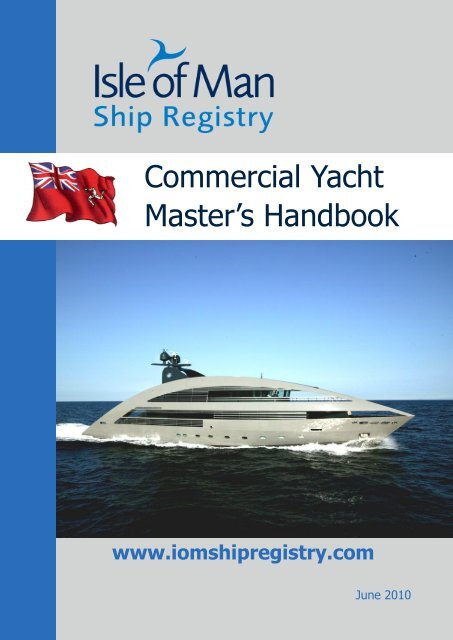
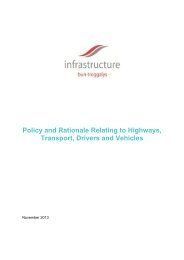
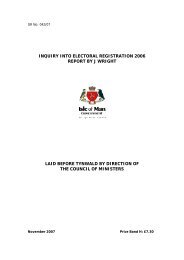
![Smeaton v Equifax CA[2013] EWCA Civ 108](https://img.yumpu.com/22052507/1/184x260/smeaton-v-equifax-ca2013-ewca-civ-108.jpg?quality=85)

